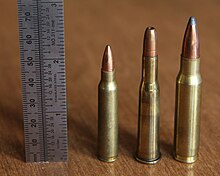
Rimfire ammunition is a type of firearm metallic cartridge whose primer is located within a hollow circumferential rim protruding from the base of its casing. When fired, the gun's firing pin will strike and crush the rim against the edge of the barrel breech, sparking the primer compound within the rim, and in turn ignite the propellant within the case. Invented in 1845, by Louis-Nicolas Flobert, the first rimfire metallic cartridge was the .22 BB Cap cartridge, which consisted of a percussion cap with a bullet attached to the top. While many other different cartridge priming methods have been tried since the mid-19th century onwards, such as pinfire, only small caliber rimfire and centerfire cartridges have survived to the present day with regular usage. The .22 Long Rifle rimfire cartridge, introduced in 1887, is by far the most common ammunition in the world today in terms of units sold.
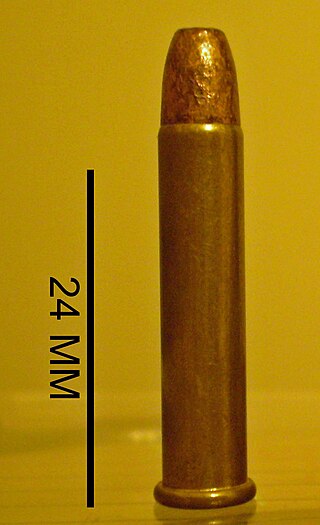
The .22 Winchester Magnum Rimfire, also called .22 WMR, .22 Magnum, .22 WMRF, .22 MRF, or .22 Mag, is a rimfire cartridge. Originally loaded with a bullet weight of 40 grains (2.6 g) delivering velocities in the 2,000 feet per second (610 m/s) range from a rifle barrel, .22 WMR is now loaded with bullet weights ranging from 50 grains (3.2 g) at 1,530 feet per second (470 m/s) to 30 grains (1.9 g) at 2,200 feet per second (670 m/s).
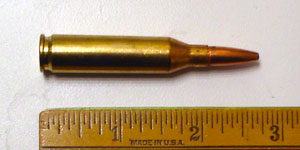
The .243 Winchester (6×52mm) is a popular sporting rifle cartridge. Developed as a versatile short action cartridge to hunt both medium game and small game alike, it "took whitetail hunting by storm" when introduced in 1955, and remains one of the most popular whitetail deer cartridges. It is also commonly used for harvesting blacktail deer, pronghorns and mule deer with heavier rounds, and is equally suited to varmint hunting with lighter rounds. The .243 is based on a necked down .308 Winchester, introduced only three years earlier. Expanding monolithic copper bullets of approximately 80 to 85 grains or traditional lead rounds of 90 to 105 grains with controlled expansion designs are best suited for hunting medium game, while lighter rounds are intended for varmints.
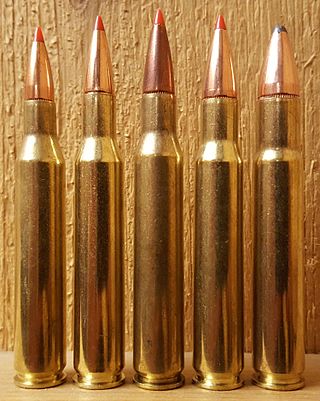
The .270 Winchester is a rifle cartridge developed by Winchester Repeating Arms Company in 1923 and it was unveiled in 1925 as a chambering for their bolt-action Model 54 to become arguably the flattest shooting cartridge of its day, only competing with the .300 Holland & Holland Magnum, also introduced in the same year.
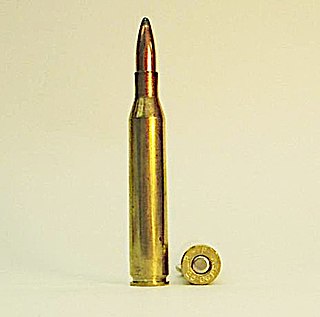
Considered by many as the most balanced of the "quarter bores" for hunting medium-sized game, the .25-06 Remington remained in obscurity as a wildcat cartridge for nearly half a century before being standardized by Remington in 1969.

The 7mm-08 Remington is a rifle cartridge that is almost a direct copy of a wildcat cartridge developed around 1958 known as the 7mm/308. As these names would suggest, it is the .308 Winchester case necked down to accept 7 mm (.284) bullets with a small increase in case length. Of cartridges based upon the .308, it is the second most popular behind only the .243 Winchester. However, the .308 is more popular than both. In 1980, the Remington Arms company popularized the cartridge by applying its own name and offering it as a chambering for their Model 788 and Model 700 rifles, along with a limited-run series within their Model 7600 pump-action rifles during the early 2000s.
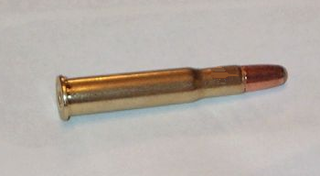
The .30-30 Winchester cartridge was first marketed for the Winchester Model 1894 lever-action rifle in 1895. The .30-30, as it is most commonly known, along with the .25-35 Winchester, was offered that year as the United States' first small-bore sporting rifle cartridges designed for smokeless powder. Since its introduction, it has been surpassed by many cartridges in the long-range shooting attributes of speed, energy, and trajectory, yet remains in widespread use because of its practical effectiveness in forested hunting situations.
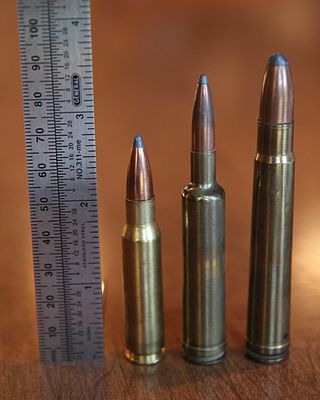
The .257 Weatherby Magnum is a .257 caliber (6.53 mm) belted bottlenecked cartridge. It is one of the original standard length magnums developed by shortening the .375 H&H Magnum case to approx. 2.5 in (64 mm). Of the cartridges developed by Roy Weatherby, the .257 Weatherby Magnum was known to have been his favorite, and the cartridge currently ranks third in Weatherby cartridge sales, after the .30-378 Weatherby Magnum and the .300 Weatherby Magnum.
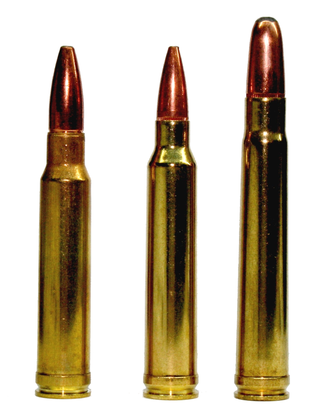
The .300 Winchester Magnum is a belted, bottlenecked Magnum rifle cartridge that was introduced by the Winchester Repeating Arms Company in 1963. The .300 Winchester Magnum is a magnum cartridge designed to fit in a standard rifle action. It is based on the .375 H&H Magnum, which has been blown out, shortened, and necked down to accept a .30 caliber (7.62 mm) bullet.

The .338 Winchester Magnum is a .338 in (8.6 mm) caliber, belted, rimless, bottlenecked cartridge introduced in 1958 by Winchester Repeating Arms. It is based on the blown-out, shortened .375 H&H Magnum. The .338 in (8.6 mm) is the caliber at which medium-bore cartridges are considered to begin. The .338 Winchester Magnum is the first choice among professional brown bear guides in Alaska to back up clients where a powerful stopping caliber is required on charging bears. It is also the most popular medium-bore cartridge in North America and has the most widely available choice in rifles among medium bore rifles. The action length is the same as a .30-06, and most major rifle manufacturers in the United States chamber rifles for the cartridge including the semi-automatic Browning BAR Mk II Safari, making it a very powerful combination against charging dangerous game. The cartridge was intended for larger North American big-game species and has found use as for the hunting of thin-skinned African plains-game species.
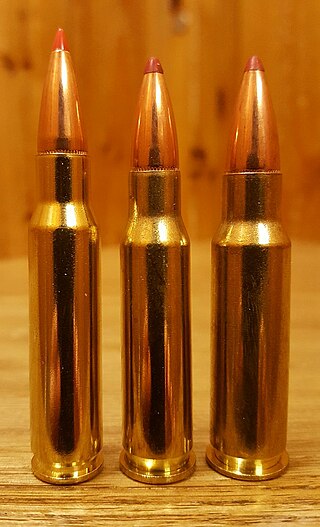
The .308 Marlin Express is a cartridge developed in 2007 by Marlin Firearms and Hornady. It is based on the .307 Winchester with a goal to duplicate .308 Winchester performance. The cartridge uses a slightly shorter, semi-rimmed case similar to that of the .220 Swift to function in lever-action rifles. As introduced in Hornady's LEVERevolution line of cartridges, it is the highest velocity production cartridge designed for lever action rifles with tubular magazines. It is chambered in Marlin's Model 308MX and 308MXLR rifles using the Marlin Model 336 action.
The 7-30 Waters cartridge was originally a wildcat cartridge developed by author Ken Waters in 1976 to give better performance to lever-action rifle shooters than the parent .30-30 Winchester cartridge, by providing a higher velocity and flatter trajectory with a smaller, lighter bullet. By 1984, Winchester introduced a Model 94 rifle chambered for the 7-30 Waters, establishing it as a commercial cartridge. In 1986, Thompson/Center began chambering 10-inch, 14-inch, and 20-inch Contender barrels for the cartridge.

The .32-40 Ballard, also known as .32-40 Winchester is an American rifle cartridge.

The .348 Winchester is an American rifle cartridge. It was introduced in 1936, and developed for the Winchester Model 71 lever action rifle. The .348 was one of the most powerful rimmed rounds ever used in a lever action rifle.

The .375 Weatherby Magnum (9.5×73mmB) is a medium-bore rifle cartridge. The cartridge is blown out, improved and provided with the Weatherby double radius shoulder – given the Weatherby treatment – version of the .375 H&H Magnum. Unlike other improved versions of the .375 H&H Magnum like the .375 Ackley Improved, the .375 Weatherby Magnum is not a wildcat and existed as a proprietary cartridge until the CIP published specifications for the cartridge.

The .450 Marlin is a firearms cartridge designed as a modernized equivalent to the .45-70 cartridge. It was designed by a joint team of Marlin and Hornady engineers headed by Hornady's Mitch Mittelstaedt, and was released in 2000, with cartridges manufactured by Hornady and rifles manufactured by Marlin, mainly the Model 1895M levergun. The Browning BLR is also now available in .450 Marlin chambering, as is the Ruger No. 1. Marlin ceased manufacture of the 1895M rifle in 2009. In October 2022 it was rumored that Ruger Firearms, the new owner of Marlin Firearms, may be reintroducing the 450 Marlin in their Model 1895 guide gun, but this has not been confirmed by Marlin or Ruger.

The .401 Winchester Self-Loading is an American rifle cartridge.

The .338 Marlin Express is a cartridge developed by Marlin Firearms and Hornady. It is based on the .376 Steyr with a goal to duplicate the venerable .30-06 Springfield's performance in a cartridge compatible with lever-action firearms. The cartridge uses a slightly shorter, rimmed case to function in lever-action rifles with tubular magazines. As introduced in Hornady's LEVERevolution line of cartridges, it follows the design logic of the .308 Marlin Express which preceded it. The .338MX fires heavier .338 caliber bullets than the .308 Marlin Express at roughly the same velocity. It is chambered in Marlin's Model 338MX and 338MXLR rifles using the Marlin Model 336 action.

Varmint rifle is an English term for a small-caliber precision firearm or high-powered airgun primarily used for both varmint hunting and pest control. These tasks include killing three types of pests or nuisance animals that spread diseases or destroy crops or livestock:
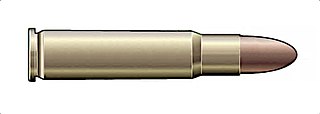
The .356 Winchester is a semi-rimmed, bottle-necked, centerfire rifle cartridge which was designed for use in lever-action rifles. It was developed concurrently with the .307 Winchester which acted as the parent cartridge. Both cartridges were introduced in 1982 in the then-new Model 94 XTR lever-action rifle.
